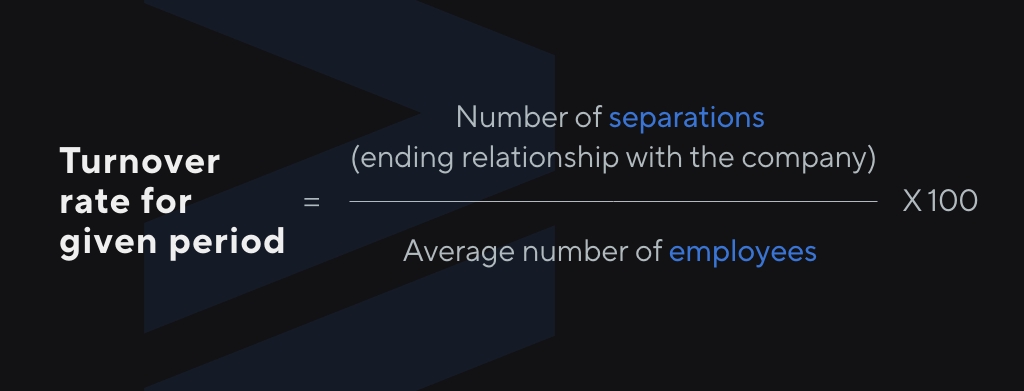The total number of employees ending their relationship with the company, including both voluntary (people looking for new jobs, change priorities, retire) and involuntary (performance or compliance issues, layoff, reductions) terminations of contract, makes up for industry turnover.
How high is too high?
Employee turnover increased by the end of the previous decade and remained high regardless of turbulence in the labor market caused by the pandemic. The industrial sector is vulnerable to employment rates. To ensure productivity and continuity of operations, enterprises need to understand the causes and consequences of the workforce outflow, followed by solutions aimed at maintaining sufficient staffing levels.
What is a sufficient workforce? That varies depending on the industry, season, and other factors, considered within a broader context appropriate for the company.

As shown above, the turnover rate reflects the % of employees leaving the company within a certain time. Without delving into the details, we can state it roughly: high employee turnover is an undesired occurrence, viewed as an adverse key performance indicator (KPI). Staff leaving the company in significant volumes indicates internal problems and if it isn’t addressed in a timely manner, results in subsequent further operational difficulties.
Various markets and industries, similar problems
In the United States employee turnover reached 57,3% in 2020, with the local market losing yearly 18% of the workforce (⅔ of which resulted from voluntary separations). Industries like food services and retail carry higher rates, reaching up to 65% and 73% accordingly.
Turnover in the UK equals approximately 15%, while the numbers differ from industry to industry. In the case of the IT or telecommunication sector, the rate in 2020 exceeded 50%, while in retail and engineering oscillated at approximately 8.3% level. Reasons for a very noticeable disproportion between the US and UK can be sought in the phenomenon of the so-called Great Resignation in the pandemic-era States. In greater detail, the causes include the longing for better wages, job security, retirement benefits, and opportunities for advancement.
Luckily for the industrial sector, the manufacturing enterprises seem to be more resilient against employee churn, but that doesn’t mean the problems aren’t just round the corner. The heavy industry in Germany faces an upcoming shortage of workforce due to the retirement of the baby boomer generation. While the industrial sector has more optimistic rates compared to e.g. hospitality (21% turnover versus 68,1% as of 2019), companies are aware of the generational change that will take place in the upcoming years. Even now, filling vacancies with qualified personnel takes on average over 130 days, according to the German federal job agency. The market that struggles to fill in nearly 600 000 vacancies will soon face a direr problem when the most experienced employee will leave the market for good.
What are the causes of employee turnover in the industrial sector?
The reasons for employee dissatisfaction are similar across industries and most commonly include:
- Burnout
- Being overworked, overburdened
- Being underpaid
- Working understaffed
- Carrying too big responsibilities with insufficient compensation
- Safety issues
- Poor relations with superiors (and, less often, with peers)
- Lack of feedback and recognition
- No opportunity for development and growth

presentation to try
Nsflow in action
What are the effects of employee turnover?
High turnover affects the business negatively in various ways.
Reputation
Companies with an opinion of employers not taking sufficient care of employees struggle with filling vacancies, as candidates in times of the employees’ market choose better options than “revolving door employers”.
Customer service
Losing experienced staff has an impact on end-users. The decrease in overall quality and customer service usually results in a decline in satisfaction and brand trust.
Productivity
The longer positions remain vacant, the bigger the risk of losing revenue and market competitiveness. Even with the influx of new, skilled staff, their adjustment period most often slows down the team or department efficiency.
Knowledge churn
With staff leaving the organization, the expertise they’ve gathered over the years outflows, causing the company to suffer the effects of tribal knowledge. Just imagine, thousands of employees with a few decades of experience retiring without the possibility to fully transfer the knowledge they acquired.
Costs
Hiring a new team member costs approximately $4,000, according to Glassdoor. Moreover, recruiting executive staff can multiply the costs by 3. The issue is closely related to the mentioned above, as training new hires is a significant expense, especially when carried out in the traditional classroom model.
Morale decrease
In cases of greater turnover, staff that witnesses coworkers continuously come and go can lose the willingness to remain in such a workplace.
While the phenomenon of (balanced) employee churn itself is not a bad thing – it allows companies to replace unfit employees with more suitable and productive staff, adding value to the business – keeping it in check is necessary to maintain a profitable industrial entity.
What can enterprises do and what countermeasures to implement to halt the undesired outflow of the workforce?
How to prevent employee turnover?
It depends.
There’s lots of vague advice to be heard in the industry. From hiring the right people (easy to say, a tad harder to execute in times of employee shortage), offering flexibility (not always possible, especially in plants working fixed shifts), to focusing on the right employee experience (improving onboarding), and implementing efficient knowledge management and competency development processes.
Even seemingly small changes in procedures can make a big difference in staff retention. Once the trends are identified, the causes pinpointed, implementation of targeted solutions can start and contribute to better retention.
We may not have answers to all the problems causing employee turnover, but we do know one thing for sure. Providing employees with solid training, conducting well-thought-out onboarding, and granting access to standardized learning materials contribute to better employee retention.
The numbers don’t lie. Ensuring relevant training opportunities is worth it. And it’s risk-free. Try our 14-day free demo and see how augmented reality can boost your industrial learning experience, helping you with retaining employees and their knowledge.



















